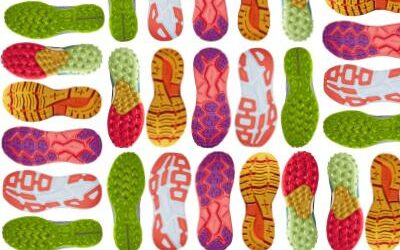
In basic terms, “energy products” comprise easy-to-consume calories packaged in simple containers for on-the-go nutrition. These products are typically used in long(er) duration exercises which have the possibility of heavily taxing or even depleting your energy stores. Think of going on a long run, hike, or bike ride that lasts for an hour or substantially more.
WHY USE THEM?
Calories! Energy products provide easily digestible calories to help replenish what you’ve burned and to keep you going for far longer than you’d be able to without their use. We won’t get into the nitty-gritty world of individualized nutrition plans, but just know that everyone’s needs are DIFFERENT. For example; body size, air temperature, activity type, intensity, and personal preference will all affect your nutritional needs.¹
HOW TO MAKE A BASIC PLAN.
A successful nutrition plan takes into account the number of calories your system can handle in an hour, and should also factor in your body’s need for electrolytes, amino acids, water, and protein.²
Guenergy.com gives us a good example of what an activity-based nutritional plan could look like. In the following example, Gu is using one’s marathon finishing time to estimate their caloric, fluid, sodium, and amino acid needs.
You can see that as the duration of activity lengthens, the number of calories needed increases. For optimal performance, someone finishing a marathon in 5 hours needs up to 1500 more calories during their race than someone finishing in 2.5 hours!
WHAT’S IN ’EM?
- Different products contain different amounts of carbs, electrolytes, caffeine, BCAA’s, fats, etc… so find the ones that are right for you.
- Carbohydrates: easily digested fast-burning energy for endurance activities. This should be your primary fuel source
- Electrolytes (sodium, potassium, magnesium): lost in sweat, need to be replenished in high concentrations, necessary for neuronal signaling and fluid balance.
- BCAAS (branched-chain amino acids): Recovery/muscle growth after exercise. Delays Fatigue during exercise. Extra fuel source when glycogen stores run out.
- Caffeine: additive in some products; helps with mental focus and reduced perceived exertion (how hard it feels) while also increasing circulating adrenaline. Caffeine is a proven performance enhancer.
- Fat is a macromolecule containing nine calories per gram that is predominantly metabolized during low-moderate intensity exercise.
WHAT ABOUT REALLY LONG ACTIVITIES?
For ultra-distance activities and endurance races, it can be beneficial to consume a slow-burning fuel source like fats in addition to carbs. Fats can be found in a variety of foods and snacks such as eggs, cheese, avocados, and olive oil. Some of the most popular options for active use are nuts and nut butters.
Trail Butter is an excellent option for those looking for this type of slow-burning fuel. It’s made from a blend of almonds and various other nuts and oils with a few sugars (like honey) thrown in for taste and that instant energy boost that carbs give.
HOW OFTEN SHOULD I TAKE THEM?
For activities lasting more than an hou,r it’s recommended to consume 200-400 calories per hour. The longer the activity the closer you’ll want to be to the 400cal/hour mark, and the sooner you’ll want to start ingesting those calories.
WHY CHOOSE ONE TYPE OF ENERGY PRODUCT OVER ANOTHER?
Aside from brand specific differences in flavor and ingredients, most brands and forms of energy products contain the same core components; carbs and electrolytes. So if you’re just looking for a rapidly burning fuel source that also replaces the electrolytes lost via sweat, they will all function similarly.
GELS/CHEWS/DRINKS.
What’s your favorite form? This comes down to convenience/preference and how an individual’s stomach tolerates various substances.
Gels are easier to quickly ingest than solid food during activity. They typically require zero chewing and are very compact. They can be easily stored in the small back pocket found in many running shorts and cycling jerseys.
Chews are sometimes more easily stomached than gels, and while a full serving will often take up more space (and weigh slightly more), you can choose to eat partial servings by taking only one or two chews from a pack while storing the rest away. This would be very messy with a gel.
Drinks are great for those who struggle with keeping down solid foods during strenuous activity. They also work well as a supplement to solid-like energy products when trying to take in a lot of calories.
THE DEETS!
BCAA’S
“BCAAs” refer to a subset of essential amino acids comprising leucine, valine, and isoleucine. BCAA’s, which are metabolized in the muscle, work to prevent the consumption of existing muscle tissue during and after exercise. Leucine, the most important amino acid, is critical in initiating protein synthesis, the process through which your muscles rebuild and get stronger.³
- Essential (must be taken in via diet) Leucine, Valine, Isoleucine
- Rapidly absorbed, mostly metabolized in muscle tissue (vs liver)
- Regulate metabolic state (recovery/building vs breakdown)
- Leucine upregulates protein synthesis
- Prevents peripheral and central fatigue
- Peripheral (muscle) fatigue prevented by BCAA breakdown as alternative energy source once glycogen stores are consumed
- Central (nervous) fatigue prevented by BCAAs binding to and blocking tryptophan from entering brain
- Prevents excess muscle breakdown
- Upregulates muscle synthesis vs catabolism
- Less breakdown during exercise and quicker recovery + more muscle building after exercise
- Consumed as alternative fuel before your own lean muscle tissue in long endurance activities (marathons, ultras, etc) preventing “muscle wasting”
- Studies have shown supplementation improves aerobic and anaerobic performance values (VO2 max, power, etc) vs placebo
- Fortify the immune system
- Gut immune cell fuel + generally improved recovery = less immune strain/fatigue
- 4-20g of BCAAS per day recommended
- Amount in a regular GU = 450mg
- Amount in Gu Roctane = 1.425g
CAFFEINE
Studies have found that caffeine can stimulate your central nervous system, which can decrease perception of pain and effort during exercise. It also enhances performance by increasing focus and priming your body for action. In addition to these effects, caffeine also has the ability to spare your glycogen stores.⁴
- Increases circulating epinephrine (adrenaline), bolstering the flight or fight response
- Many effects including increased heart rate, blood flow, oxygen intake, and blood glucose levels
- Prevents neural “braking” (decreased activity) by blocking adenosine receptors. Ie: keeps nervous system activity high.
- Inhibits degradation or reuptake of cAMP which is involved in downstream signaling of adrenaline (perpetuating the effects of adrenaline)
- Mental clarity, specifically early races crucial for staying focused and not being complacent
- Reduces perceived effort = better mental game
- 1-3mg/kg body weight = small dose
- 3-6mg/kg = maximum performance benefit
- Most brands have multiple flavor options per type (gel, chew, etc…) of product containing caffeine.
- Shown to give a significant performance boost, specifically if one is genetically predisposed to process caffeine quickly.
- Helpful early morning boost
- May not be necessary for mid-day activities where performance is not being tested or for activities shortly before bedtime.
CALORIES
Calories are the base units for measuring the energy content of foods. Carbohydrates contain 4 calories/gram; fats contain 9 calories/gram, and protein contains 4 calories/gram. When you deplete your calorie stores during exercise, you quite literally run out of gas! This is what is often referred to as bonking, and it’s extremely detrimental to your athletic performance.⁵
CARBOHYDRATES
Carbohydrates are chainlike molecules composed of carbon, oxygen, and hydrogen. This broad category of macronutrient includes the sugars, starches and fibers found in fruits, grains, vegetables and milk products that are converted into blood glucose by your body to be used for energy. They typically make up around half of one’s daily caloric intake.⁶
- Fuel source necessary for muscular exertion. Carbs –> ATP –> Muscle Movement (and general cellular functioning)
- 30-60g carbs/hour for activities longer than one hour (as recommended by Clif)⁸.
ELECTROLYTES
Electrolytes are minerals found in your body and blood that affect how your body functions, particularly during exercise. When you sweat, you lose electrolytes. And, as anyone who’s ever tasted their own sweat during a hard workout knows, sweat is salty. That’s because the primary electrolyte you lose when you sweat is sodium.⁷
- Keeps you from developing hyponatremia (low blood-sodium levels) while ingesting large quantities of fluids (which you should).
- Prevents muscle cramping.
- Generally responsible for maintaining fluid balance between cells, tissues, and surrounding space in the body.
- Necessary component of neuronal firing process (specifically NA+ and K+).
- Sodium specifically, is co-absorbed with glucose and other molecules so it’s optimal to consume with other calories (like in gu gel or clif blok) vs alone in a liquid solution⁹.
- Large quantities of electrolytes are lost in sweat so this is a rapidly depleting resource, especially in hotter weather.
References:
¹⁻⁷‚⁹, guenergy.com
⁸, clifbar.com



